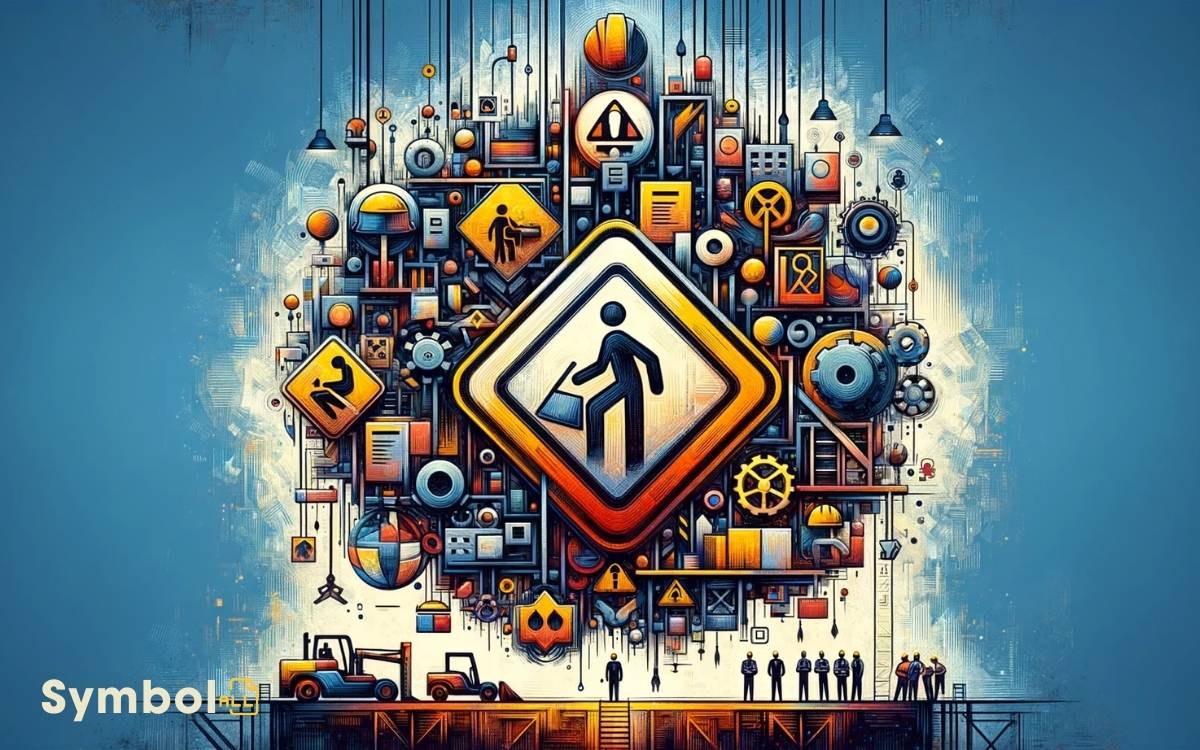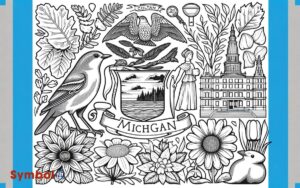Although Osha Created No Symbols or Specific Color Designations
Although OSHA hasn’t mandated specific symbols or colors, it guarantees your workplace meets safety and health standards. Its regulations evolve to address new challenges, focusing on hazard communication and emergency preparedness.
You must understand OSHA’s Hazard Communication Standards and the significance of safety symbols and color coding in maintaining a safe environment.
While universal symbols offer global comprehension, OSHA’s approach caters specifically to U.S. regulations, requiring adaptation across different industries.
Adhering to these guidelines is essential, and exploring the nuances of OSHA’s strategies can further enhance your workplace’s safety measures.

Key Takeaway
The Role of OSHA
OSHA, the Occupational Safety and Health Administration, plays a critical role in ensuring workplace safety and health standards across various industries.
As you’re maneuvering the complexities of workplace safety, it’s essential to understand that OSHA‘s mandate isn’t just about setting arbitrary rules.
Instead, they’re tasked with developing and enforcing regulations that prevent work-related injuries, illnesses, and deaths.
This involves rigorous research, stakeholder engagement, and continuous monitoring of workplace environments.
You’ll find that OSHA’s guidelines aren’t static; they evolve in response to new safety challenges and technological advancements.
Their approach is inclusive, covering everything from hazard communication to emergency preparedness.
Existing Safety Symbols
You must understand that OSHA’s hazard communication standards are integral to workplace safety, emphasizing the critical role of existing safety symbols.
These symbols, coupled with distinct color codings, serve as immediate visual cues for hazard awareness and prevention. These symbols, coupled with distinct color codings, serve as immediate visual cues for hazard awareness and prevention. For instance, the use of the color red often signifies danger or the need for caution, a concept that extends beyond safety protocols into literature and art. The color red meaning in The Great Gatsby also evokes strong emotions, symbolizing passion, desire, and, at times, violence or corruption, further underscoring its powerful and multifaceted implications. By leveraging such universally recognized associations, these visual tools communicate critical messages efficiently and effectively.
It’s crucial to familiarize yourself with these designations to guarantee compliance and uphold a safe working environment.
Hazard Communication Standards
Understanding OSHA’s Hazard Communication Standards is essential for identifying and interpreting the array of existing safety symbols in the workplace.
These symbols are vital for guaranteeing safety and compliance. They operate as visual cues, guiding you through potential hazards and mandatory actions or precautions.
Here’s a concise table summarizing key symbols under these standards:
| Symbol | Description | Hazard Category |
|---|---|---|
|  | Indicates flammable materials | Fire Hazard |
|  | Warns of toxic and fatal substances | Health Hazard |
|  | Signals moderate hazards, like irritants | General Hazard |
|  | Identifies corrosive substances to metals/skin | Chemical Hazard |
This regulatory framework ensures you’re equipped to navigate through hazardous environments safely.
Color Coding Awareness
Recognizing the importance of color coding in existing safety symbols is crucial for ensuring workplace safety and compliance. You must understand that each color used in safety symbols conveys specific information.
- Red, for instance, signifies danger, alerting you to stop or exercise caution.
- Yellow, often associated with caution, indicates potential hazards that could harm if proper precautions aren’t taken.
- Green symbolizes safety, directing you towards safe passages or first aid equipment.
- Blue, typically used for informational signs, provides general information about equipment or areas. It’s imperative you familiarize yourself with these color codes.
Their consistent application across various contexts aids in quickly recognizing and reacting to potential hazards, thereby enhancing your safety and that of your colleagues.
Industry-Specific Protocols
You must recognize that industry-specific protocols in safety signage and color codes necessitate a nuanced understanding.
Custom safety signage, color coding variations, and regulatory compliance differences are critical for ensuring workplace safety across diverse sectors.
These components demand your meticulous attention to detail and adherence to OSHA standards.
Custom Safety Signage
Custom safety signage, tailored to industry-specific protocols, plays a crucial role in guaranteeing workplace safety by providing clear, immediate guidance.
You’re obligated to understand that these customized signs go beyond general warnings, incorporating specific hazard information, procedural instructions, and emergency directions relevant to the unique risks your industry faces.
They’re not just tools for compliance; they’re essential components in a broader safety culture that prioritizes the well-being of every employee.
By integrating industry-specific language, symbols, and formats, these signs ensure that the message isn’t just seen but understood, greatly reducing the risk of accidents and injuries.
It’s your duty to ensure that these custom signs meet regulatory standards while also addressing the particular needs of your workplace, thereby enhancing safety protocols.
Color Coding Variations
Industry-specific protocols dictate that color coding variations play a pivotal role in enhancing safety measures by providing clear, immediate visual cues.
You must understand that each sector may adopt unique color schemes to address its specific risks and requirements.
For example, in the chemical industry, colors signify different types of hazards, enabling workers to recognize dangerous substances quickly.
Similarly, in healthcare, color coding aids in preventing cross-contamination by distinguishing between clean and sterile areas versus potentially infectious ones.
These variations aren’t arbitrary but are developed through rigorous analysis of the environment, potential hazards, and the most effective ways to visually communicate risk.
Adhering to these color codes is paramount in maintaining a safe workplace, ensuring that every employee, regardless of their role or experience, can instantly understand the safety messages conveyed through colors.
Regulatory Compliance Differences
While color coding serves as a universal language for safety, the regulatory frameworks governing these protocols vary considerably across different industries.
You’ll find that specific sectors, such as chemical manufacturing, construction, and healthcare, adhere to unique sets of guidelines that dictate the use of safety colors and symbols.
This diversity stems from the distinct hazards and operational contexts inherent to each industry.
As a stakeholder, you’re required to navigate these differences, ensuring your practices align not just with OSHA’s overarching standards but also with sector-specific regulations.
This necessitates a nuanced understanding of the regulatory landscape, where compliance isn’t merely a matter of adopting a one-size-fits-all approach but tailoring your safety protocols to meet the precise demands of your industry’s regulatory environment.
Universal Symbols Vs. OSHA
Exploring the landscape of workplace safety, you’ll find distinct differences between universal symbols and those specific to OSHA’s regulations.
Universal symbols, recognized globally, aim for immediate comprehension across language and cultural barriers, encompassing signs for hazards like fire, electricity, and toxic substances.
They’re designed to be intuitively understood, leveraging common human experiences and perceptions.
Conversely, OSHA’s symbols are entrenched in legislative standards specific to the United States, focusing on compliance within American workplaces.
They may include detailed instructions and hazards communication that align with U.S. regulations, often requiring specific training to fully comprehend.
This regulatory approach guarantees that safety protocols meet the stringent criteria set forth by U.S. law, but mightn’t be as instantly recognizable to a global workforce without that specific training.
The Gap in Visual Communication
Bridging the gap in visual communication requires a nuanced understanding of the contrast between universal symbols and OSHA’s specific safety signs.
You must recognize:
- The Importance: OSHA’s signs mightn’t be instantly recognizable across different industries or cultural backgrounds.
- Adaptation Needs: Workplaces have unique hazards that standardized signs may not adequately address.
- Language Barriers: Workers with diverse linguistic backgrounds might find text-heavy warnings less effective.
- Technological Advances: New risks emerge that existing signs don’t cover, necessitating updates or entirely new symbols.
This gap highlights the significance of evolving safety communications to meet contemporary needs. It’s important to assess and revise safety signages and symbols regularly, ensuring they remain effective across varied work environments and among diverse worker populations.
Alternative Safety Measures
You must explore alternative safety measures beyond OSHA’s symbols and color designations to enhance workplace safety.
Implementing visual warning systems can greatly reduce accidents by providing clear, immediate hazards identification.
Additionally, enhancing workplace communication and adopting behavioral safety practices are critical for fostering a culture of safety and compliance.
Implementing Visual Warning Systems
Implementing visual warning systems serves as a critical alternative safety measure, enhancing workplace safety by providing clear, immediate cues for potential hazards.
Here’s how you can effectively integrate these systems:
- Identify Areas of Risk: Conduct a thorough risk assessment to pinpoint where visual warnings will yield the most benefit.
- Select Appropriate Symbols: Choose universally recognized symbols to guarantee comprehension across diverse workforces.
- Implement Color Coding: Utilize distinct colors to categorize hazards, facilitating quicker recognition and response.
- Regular Maintenance: Guarantee these systems are regularly checked and updated to maintain their effectiveness and relevancy.
Enhancing Workplace Communication
Enhancing workplace communication, as an important alternative safety measure, demands a strategic approach to guarantee clear, efficient, and effective dissemination of safety-related information.
You must prioritize the establishment of inclusive communication channels that cater to the diverse needs and preferences within your workforce.
This entails adopting multi-faceted communication platforms, ranging from digital bulletin boards to mobile alerts, ensuring that safety messages reach every employee without ambiguity.
Additionally, fostering an environment that encourages open dialogue about safety concerns and recommendations greatly contributes to the proactive identification and mitigation of potential hazards.
Adopting Behavioral Safety Practices
Adopting behavioral safety practices requires a thorough understanding of how employees’ actions directly impact workplace safety. You’ll need to analyze and adjust behaviors to promote a safer working environment.
Here are four critical steps to implement:
- Conduct Behavioral Audits: Regularly assess workplace behaviors to identify potential safety risks.
- Develop Training Programs: Customize safety training to address specific behavioral issues and reinforce positive practices.
- Establish Feedback Mechanisms: Create channels for employees to report unsafe behaviors without fear of retaliation.
- Monitor and Adapt: Continuously monitor behavioral changes and adjust strategies as needed to ensure ongoing improvement in safety measures.
International Standards Comparison
Understanding the differences between OSHA’s symbols and color designations and those of international standards can greatly impact compliance and safety practices globally.
OSHA, primarily governing U.S. workplaces, has established a set of guidelines that may not always align with international standards such as those set by the International Organization for Standardization (ISO) or the European Union (EU).
These discrepancies can lead to confusion and potential non-compliance for multinational companies.
For instance, color codes and symbols used to indicate hazards vary, necessitating a thorough analysis and adaptation by businesses operating across borders.
Additionally, the terminology and categorization of risks might differ, requiring careful translation and application of safety protocols.
Understanding these variances is important for ensuring global safety compliance and minimizing the risk of workplace accidents and regulatory penalties.
Potential for New OSHA Symbols
In the rapidly evolving landscape of workplace safety, OSHA’s consideration of introducing new symbols necessitates a close examination by businesses to stay compliant and guarantee employee protection.
The potential introduction of these symbols presents a proactive approach to addressing emerging hazards and technologies in the workplace.
As you navigate these changes, consider:
- The importance of symbols to new hazards
- The clarity and universal comprehension of proposed symbols
- The integration process for existing safety protocols
- The training requirements for staff and management
Understanding these elements is vital for businesses aiming to stay ahead in maintaining a safe working environment.
Adapting to OSHA’s evolving guidelines ensures not only compliance but also a commitment to the well-being of your workforce.
Challenges of Implementation
Implementing OSHA’s new symbols presents several challenges for businesses, including logistical hurdles and the need for thorough training programs.
You’ll find that aligning existing safety protocols with new standards demands not only time but also financial resources.
Here’s a concise breakdown of some key challenges:
| Challenge | Solution |
|---|---|
| Cost | Budget allocation |
| Training | In-depth programs |
| Compliance | Regular audits |
| Integration | System updates |
| Communication | Clear internal channels |
Each of these elements requires a strategic approach to make sure that your organization not only meets but exceeds OSHA’s expectations. It’s essential to understand that these challenges, while formidable, offer a pathway to a safer and more compliant workplace.
Your dedication to addressing these obstacles reflects your commitment to the well-being of your employees.
Future of Workplace Safety
As we look toward the horizon, the future of workplace safety hinges on the integration of advanced technologies and stringent regulatory measures.
You’ll find that to safeguard employees and guarantee compliance, the following areas are vital:
- Implementation of Real-time Monitoring Systems: Utilizing sensors and IoT devices for instant hazard detection.
- Adoption of Artificial Intelligence: AI can predict potential safety risks by analyzing data patterns, enhancing preemptive measures.
- Enhanced Training through Virtual Reality: VR provides realistic simulations, preparing workers for emergency scenarios without exposing them to real danger.
- Stricter Enforcement of Regulations: Governments and regulatory bodies must intensify oversight and penalties for non-compliance to deter negligence.
Each of these components plays a pivotal role in shaping a safer work environment, ensuring that safety protocols evolve alongside technological advancements.
Conclusion
To sum up, isn’t it clear that the absence of OSHA-specific symbols leaves a significant gap in visual communication for workplace safety?
While universal symbols and industry-specific protocols serve their purpose, the potential for OSHA to develop its own symbols could bridge this gap, enhancing clarity and compliance.
However, the challenges of implementation can’t be underestimated. As we move forward, the future of workplace safety hinges on a balance between innovation and practicality, ensuring regulations keep pace with evolving industry needs.






